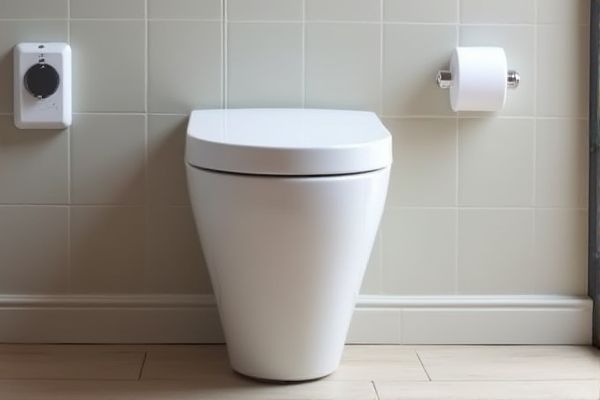
Push-button flush toilets offer a sleek, modern design with easy-to-use mechanisms that save water and reduce wear, while lever flush toilets provide a traditional and reliable option that many homeowners prefer for its simplicity and durability. Discover which flush system best suits Your bathroom needs by reading the rest of the article.
Table of Comparison
| Feature | Push-Button Flush | Lever Flush |
|---|---|---|
| Operation Mechanism | Pressing a button to release water | Pulling or pushing a lever handle |
| Design | Modern, sleek, often dual-flush options | Traditional, mechanical appearance |
| Water Efficiency | Commonly features dual-flush for water saving | Typically single flush, less water-efficient |
| Maintenance | May require button replacement or mechanism adjustment | Easy to repair or replace lever components |
| Installation | Requires compatible cistern with button fitting | Fits most standard toilets with lever setup |
| Durability | Durable but button parts may wear faster | Robust and less prone to failure |
| User Accessibility | Accessible and easy to press | May require more hand strength or dexterity |
Introduction to Toilet Flush Mechanisms
Push-button flush systems utilize a compact button typically located on the top of the toilet tank, offering a modern design and ease of use with a simple press mechanism that controls water release. Lever flush mechanisms feature a side-mounted handle connected to a lift chain inside the tank, providing a traditional method where the handle's motion initiates flush activation. Both mechanisms serve to trigger the flushing process by opening the flapper valve, but push-button models often provide dual-flush options for water conservation, unlike standard lever systems.
Overview of Push-Button Flush Systems
Push-button flush systems utilize a compact actuator designed to activate the flushing mechanism with minimal effort, often incorporating dual flush options to conserve water. These systems are typically integrated into modern toilets, offering a sleek and space-saving alternative to traditional lever flush designs. Their efficient engineering promotes reduced water usage and enhanced user convenience, making them a popular choice in contemporary bathroom fixtures.
Overview of Lever Flush Systems
Lever flush systems operate through a mechanical handle typically mounted on the side or front of the toilet tank, providing a reliable and familiar method for initiating the flush. These systems use a chain or lift wire connected to a flapper valve inside the tank, which lifts when the lever is pressed to release water into the bowl and trigger the flush. Lever flush systems are favored for their durability, ease of repair, and compatibility with a wide range of traditional toilets.
Design and Aesthetic Differences
Push-button flush systems offer a sleek, modern design with a compact, minimalistic appearance that blends seamlessly into contemporary bathroom styles. Lever flush mechanisms present a more traditional look with visible handles, often featuring decorative finishes that complement classic or vintage bathroom themes. The choice between push-button and lever flush impacts both the toilet's visual profile and the overall bathroom aesthetic.
Water Efficiency Comparison
Push-button flush systems generally offer greater water efficiency compared to lever flush models due to their dual-flush feature, allowing users to select between a full or partial flush. This precise control reduces water consumption, saving thousands of gallons annually in typical households. Your choice of flushing mechanism directly impacts water conservation, contributing to lower utility bills and environmental sustainability.
Ease of Use and Accessibility
Push-button flush systems offer superior ease of use and accessibility, requiring minimal effort and making them ideal for individuals with limited hand strength or dexterity. Lever flush handles may necessitate a gripping or twisting motion, which can be challenging for elderly users or those with arthritis. The streamlined design of push buttons also facilitates quicker, more intuitive operation in various bathroom environments.
Maintenance and Durability
Push-button flush systems generally require less maintenance due to fewer moving parts exposed to wear and tear, reducing the likelihood of leaks and mechanical failures. Lever flush mechanisms, while often more robust, may need periodic adjustments or replacements of handles and chains to maintain optimal performance. Choosing a push-button flush can enhance Your bathroom's durability by minimizing maintenance efforts over time.
Cost Considerations
Push-button flush toilets typically have a higher initial cost due to their more complex mechanism and modern design, but they can offer water-saving features that reduce long-term utility bills. Lever flush toilets are generally more affordable upfront and easier to repair, making them a cost-effective choice for budget-conscious homeowners. Evaluating both the installation expenses and ongoing water efficiency helps determine the best financial option for a specific bathroom setup.
Suitability for Different Bathroom Styles
Push-button flush systems offer a sleek, modern aesthetic ideal for contemporary or minimalist bathroom designs, enhancing the clean lines and smooth surfaces typical of these styles. Lever flush mechanisms, with their traditional and sometimes vintage appearance, complement classic or rustic bathroom decors, adding a tactile and decorative element to the fixture. Choosing between push-button and lever flush options depends on the desired bathroom ambiance and compatibility with existing design motifs.
Conclusion: Choosing the Right Flush Mechanism
Push-button flush mechanisms offer a modern, space-saving design with water-efficient dual flush options, ideal for contemporary bathrooms seeking sustainability. Lever flush systems provide reliable, straightforward operation with classic aesthetics, suitable for traditional settings and ease of use. Your choice depends on balancing style preferences, water efficiency goals, and user convenience.
 homyna.com
homyna.com